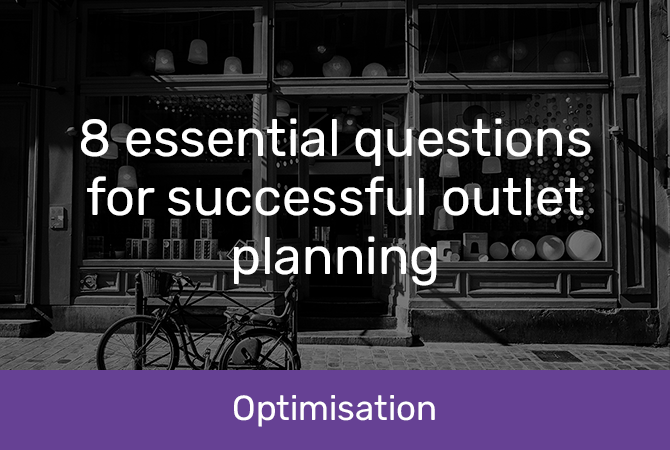
8 essential questions for successful outlet planning
Understanding market share is important – are we keeping pace with how fast the market is growing? Which competitors are we losing out to? The executive team wants a high level view; it needs to know if the organisation’s strategic direction is working. At the same time, the people involved with executing on strategy need to know more so they can continue to make great decisions. It seems that people delay making these decisions because the potential risk of making the wrong one is too great.
This conundrum is highlighted when it comes to your bricks and mortar presence – a massive cost to the business, whether you’re a retailer or a service organisation. Depending on the size, product and nature of your business, these decisions can be complex. The skill is to work out the right level of complexity for your given situation and avoid paralysis by analysis whenever possible.
What not to do when planning an outlet
Suffice to say, outlet planning no longer needs to be done by:
- Going with gut feelings
- Producing a map of outlets and looking for white space
- Drawing a circle around existing outlets and viewing that as the catchment
- Only considering some market segments and some channels, rather than all of them
For brands with a national presence, here are some questions that help ensure your bricks and mortar outlets are in the right place, thus improving business performance:
1. Is market share consistent across the country? If not, why not?2. Does market share correlate with physical presence? This is especially relevant for service businesses.
3. For retail, are you getting your expected level of turnover for each outlet? This can be calculated by understanding the local market and its potential to spend in your category. There’s nothing like benchmarking to get focus!
4. If we open a new outlet or close an existing one, what will be the impact on turnover and profit?
5. What are the population and business changes occurring and the opportunities presented by green field sites?
6. What opportunity exists for automating processes and servicing?
7. Can front-end activities be migrated to digital and self-serve?
8. Which customers can we migrate to self-serve?
When dealing with a complex national review, results from multiple studies (qualitative and quantitative) need to be combined into a cohesive view to make the discrete pieces of analysis useful. This is a challenge – one that typically cannot be tackled by a single person alone. Luckily, a scientific approach or algorithm can be developed to aid this complex decision making.
Swooping back to the start of this ramble, market share measurement is a critical factor, as it puts turnover figures into the context of the market. However, operations need to go beyond this and consider outlet benchmarking and identifying gaps / over-supply in physical presence. These are critical decisions, all of which can be underpinned by data.
Case study: Homeware chain identifies catchment cannibalisation
 Challenge
Challenge
A large homeware chain was presented with an opportunity to open a new store in a small regional city. Of concern, however, was the potential impact the new store would have on the chain's existing locations throughout the greater Waikato district. The group approached Datamine in order to gain a better understanding of what impact a new outlet would have on its sales in other stores nearby.
 Solution
Solution
Datamine used its exclusive Business Insight data source to understand more about the homeware spend in the region - and assess potential spend should the client choose to open a new store in that region. By looking at the catchment area, including five of the retailer's other stores within a specific radius, Datamine was able to estimate the potential cannibalisation factor of the proposed new store.
 Result
Result
Datamine presented the client with an accurate gauge of the market size and potential (in actual projected sales dollars) for the proposed future store given the competitors already in the area and typical market share patterns.
Cannibalisation was quantified and this assessment ranked the regional store at the lower end of the total group in terms of likely sales. Based on this assessment, it was deemed unlikely to reach the group’s internal requirements. Following the delivery of the Datamine analysis, the retailer decided not to proceed with its expansion plans into the regional city.
“Not only were Datamine easy to work with and providers of an excellent quality of service, they also helped us to avoid launching a store which would have, at best, been marginal.” - Chief Operating Officer















































